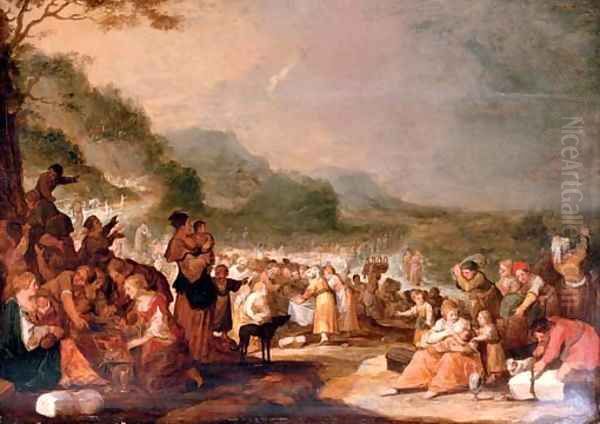Hans Jordaens III stands as a notable figure within the vibrant artistic milieu of 17th-century Antwerp. Active during the peak of the Flemish Baroque period, he carved a niche for himself primarily as a painter of detailed cabinet pieces, historical narratives, and mythological scenes, often working in collaboration with other prominent artists of his time. Though sometimes overshadowed by his more famous contemporaries, a closer look reveals a skilled artist with a distinct style and a significant role in the Antwerp art market.
Origins and Artistic Lineage
Born in Antwerp, the bustling artistic heart of the Southern Netherlands, Hans Jordaens III entered the world around 1595. Baptismal records from the Antwerp Cathedral confirm his christening on May 19, 1595. He hailed from a family deeply rooted in the city's artistic traditions. He was the son of Hans Jordaens II, also a painter, and the grandson of Hans Jordaens I (c. 1555–1630), establishing a clear artistic lineage. It is crucial to distinguish him from his slightly older and significantly more famous contemporary, Jacob Jordaens (1593–1678), who belonged to a different family, despite sharing the same city and a similar name which occasionally leads to confusion.
Hans Jordaens III likely received his initial training within the workshop of his father, Hans Jordaens II. This familial apprenticeship was a common practice in Antwerp, providing young artists with foundational skills and direct exposure to the craft. Following his training, Hans III established himself as an independent master, becoming a member of the prestigious Antwerp Guild of Saint Luke, likely around 1617 or 1620. Membership in the Guild was essential for practicing professionally, taking on pupils, and selling work within the city.
Style and Influences: The Cabinet Painter
Hans Jordaens III developed a style characterized by meticulous detail, vibrant colours, and lively figure compositions, often executed on a relatively small scale. This aligns him with the tradition of "cabinet painting," works intended for the private enjoyment of collectors, often displayed in dedicated art rooms or cabinets ('Kunstkamers'). His approach shows the clear influence of Frans Francken the Younger (1581–1642), a leading figure in this genre, known for his crowded narrative scenes filled with small, animated figures.

Like Francken, Jordaens III excelled at rendering intricate details in costumes, architecture, and landscape elements. His figures, though small, are often depicted with expressive gestures and dynamic poses, effectively conveying the narrative or emotion of the scene. He demonstrated a skillful handling of light and shadow to create depth and focus, and his palette was typically rich and varied, contributing to the decorative appeal of his works. While operating within the broader context of the Flemish Baroque, dominated by the monumental and dramatic style of Peter Paul Rubens (1577–1640) and Anthony van Dyck (1599–1641), Jordaens III cultivated a more intimate and detailed aesthetic suited to his chosen format.
There is also evidence of Italian influence in his work, possibly absorbed through prints or the works of artists who had travelled south. Echoes of North Italian painters like Jacopo Bassano (c. 1510–1592) and Paolo Veronese (1528–1588) can sometimes be discerned in his compositions and use of colour, reflecting the widespread impact of Italian art on Flemish painters of the era.
Themes and Subject Matter
Hans Jordaens III's oeuvre encompasses a range of popular subjects from the period. He frequently depicted historical and biblical narratives, demonstrating a particular interest in Old Testament stories. Works such as Moses Receiving the Law and The Adoration of the Golden Calf are indicative of this focus, often featuring numerous figures set within expansive landscapes or architectural settings. His rendition of The Crossing of the Red Sea became a recurring theme, allowing him to showcase his ability to manage complex compositions with large crowds and dramatic action.
Mythological subjects, particularly tales drawn from Ovid's Metamorphoses, were another staple of his output. Paintings like Apollo and Daphne and Cephalus and Procris illustrate his engagement with classical literature, translating these ancient stories into visually engaging scenes filled with movement and emotion. Some scholars have noted that his interpretations of Ovid could be quite nuanced, perhaps reflecting a close reading of the source texts.
A fascinating and characteristic genre for Jordaens III, linking him closely to Frans Francken the Younger, was the depiction of art collections or 'Kunstkammer' paintings. Works like An Interior of an Art Collector's Cabinet show idealized rooms filled with paintings, sculptures, scientific instruments, and natural curiosities, often including elegantly dressed figures admiring the objects. These paintings celebrated the culture of collecting and connoisseurship prevalent in Antwerp and offered artists a chance to display their virtuosity by rendering diverse textures and miniature versions of famous artworks.
Collaboration in the Antwerp Art World

The Antwerp art market in the 17th century was characterized by a high degree of specialization and collaboration, and Hans Jordaens III was deeply embedded in this system. He frequently worked with other artists, typically adding the small figures (staffage) to landscapes or architectural scenes painted by specialists. This practice allowed for efficient production and combined the strengths of different masters.
His known collaborators include prominent landscape painters such as Joos de Momper the Younger (1564–1635), Alexander Keirincx (1600–1652), and Abraham Govaerts (1589–1626). He also worked alongside Tobias Verhaecht (1561–1631), another landscape specialist who was notably Rubens' first teacher. Furthermore, collaborations with Jan Brueghel the Younger (1601–1678), son of the famous Jan Brueghel the Elder, are documented. These partnerships resulted in works where Jordaens III's lively figures populate the meticulously rendered natural or architectural settings created by his colleagues.
An interesting example of this collaborative environment occurred after the death of Abraham Govaerts in 1626. Jordaens III was among the artists, reportedly coordinated by Frans van der Steen (fl. 1604-1646), tasked with completing Govaerts' unfinished landscapes by adding the staffage. This highlights his reputation as a reliable and skilled figure painter within the Antwerp artistic community. While collaboration was common, the art scene was also competitive. Jordaens III operated in the shadow of giants like Rubens, and while direct collaboration on major projects seems less documented for Hans III compared to Jacob Jordaens (who did work extensively with Rubens), the influence and market dominance of Rubens undoubtedly shaped the environment in which Hans Jordaens III worked.
Attribution, Legacy, and Collections
As is common with artists working in collaborative workshops and within established stylistic traditions like that of the Francken family, the precise attribution of works to Hans Jordaens III can sometimes be challenging. His style is close to that of his father, Hans Jordaens II, and other followers of Frans Francken the Younger. Furthermore, the existence of multiple artists named Hans Jordaens across several generations adds another layer of complexity for art historians.
Specific works have occasionally been subject to debate or reattribution. For instance, while The Crossing of the Red Sea is a theme strongly associated with him, individual versions might be contested or reassigned upon closer scrutiny or the discovery of new evidence. Similarly, studies or preparatory drawings, like the mentioned V-c-30 (likely referring to a specific inventory number), can face questions regarding authorship. These attribution issues underscore the fluidity of workshop production and stylistic imitation during the period.

Despite these challenges, Hans Jordaens III left a recognizable body of work that contributed to the richness of Flemish Baroque painting. His skill in detailed narrative and his role as a prolific collaborator ensured his place within the Antwerp school. His paintings were acquired by collectors across Europe, and today, works attributed to him or his circle can be found in major international museums. Notable collections holding his paintings include the Gemäldegalerie Alte Meister in Dresden, the Hermitage Museum in St. Petersburg, the British Museum in London, and the Mauritshuis in The Hague, among others. His detailed cabinet paintings continue to be appreciated for their craftsmanship, narrative richness, and as windows into the artistic tastes and practices of 17th-century Antwerp.
Conclusion: A Distinct Voice in the Flemish Baroque
Hans Jordaens III emerges from the historical record as a talented and productive painter who played a significant role in the Antwerp art scene of the early to mid-17th century. Specializing in cabinet paintings filled with lively figures, he adeptly handled biblical, mythological, and allegorical themes, alongside the distinctive genre of Kunstkammer interiors. His style, heavily influenced by Frans Francken the Younger but possessing its own character, was marked by detail, colour, and animation.
Crucially, he was an active collaborator, contributing his skill as a figure painter ('Staffagemaler') to the works of numerous landscape and architectural specialists, including Joos de Momper, Alexander Keirincx, Abraham Govaerts, and Jan Brueghel the Younger. This integration into the collaborative network of Antwerp workshops was key to his career. While navigating an art world dominated by Peter Paul Rubens and Anthony van Dyck, and needing to be distinguished from his namesake Jacob Jordaens and his own familial predecessors (Hans I and Hans II), Hans Jordaens III established a distinct artistic identity. His legacy resides in the finely crafted paintings that capture the narrative energy and collecting passions of the Flemish Baroque era, securing his place as a respected master within this rich artistic tradition. He passed away in Antwerp in 1643 or 1644.